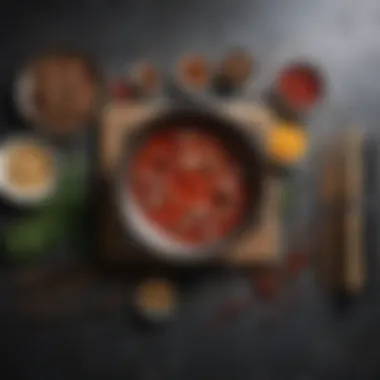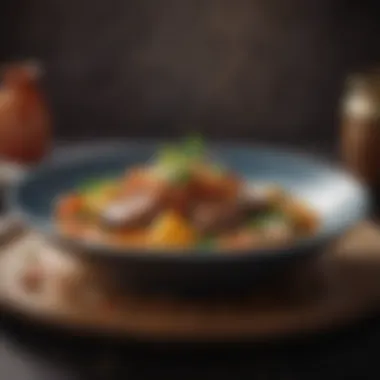Exploring the Rich Tapestry of Chinese Culinary Items


Intro
Chinese cuisine is a vast territory, rich with flavors and techniques that span thousands of years. This body of culinary art reflects the country's history, culture, and regional diversity. Each dish possesses its unique story—a narrative intertwined with geography, tradition, and awaiting discovery by enthusiasts. Learning about Chinese culinary items not only enhances one's cooking repertoire but also provides insight into a culture deeply connected with its food.
In this exploration, we will dissect significant components of Chinese cooking. Key topics will include an ingredients breakdown, specific preparation techniques, dietary concerns, as well as the variations that customize these dishes. By illuminating these elements, we aim to demystify Chinese cuisine for those eager to embark on this culinary journey.
Preface to Chinese Culinary Items
Chinese cuisine is a vast and intricate tapestry integrating centuries of history, regional diversity, and cultural significance. Understanding this culinary landscape is vital not only for enthusiasts and chefs but also for anyone interested in the art of cooking. Exploring Chinese culinary items opens up avenues for enhancing culinary skills, introducing new flavors and techniques, and broadening one’s palate. This section highlights essential elements, benefits, and unique considerations related to Chinese cuisine, preparing the ground for deeper exploration.
Definition and Scope
The term Chinese culinary items encompasses a wide variety of foods, cooking methods, and regional specialties. This includes iconic elements such as dumplings, stir-fries, and noodles, along with an array of seasonings and spices like soy sauce and five-spice powder.
Chinese cuisine is not uniform; it varies greatly from region to region, each with distinct characteristics influenced by local ingredients and cultural practices. The discussion herein will explore essential terms and familiar dishes associated with various culinary classifications. The scope extends beyond mere ingredients to encompass cooking techniques, preparation styles, and the philosophical considerations that guide the use of these items in meals. Attention will pay to how these components correlate with family gathering and festive occasions.
Historical Context
Chinese food culture has roots reaching back to ancient dynasties where culinary techniques were refined and documented. Archaeological discoveries have unveiled evidence of sophisticated food preparation as early as the Shang dynasty. These early practices were accompanied by intense agricultural development.
The arrival of various cooking methods, such as steaming and braising, aligns closely with important historical reforms and exchanges, demonstrating how geographical and social factors mingle to shape cuisine. Inspiration arose from trade routes, international exchanges, and the culinary influences of neighboring regions.
As noted in various studies, the evolution of specific dishes reflects the rich traditions and adaptations made throughout history.
In contemporary times, the significance remains clear. Chinese culinary practices are a symbol of unity and identity in diverse communities around the world. They stand not just as food but as contains of history, passion, and thought for balance, health, and flavor. Thus, studying these historical elements offers greater insight into the dynamic and living culture that underpins every dish consumed today.
Regional Variations in Chinese Cuisine
Chinese cuisine is a vast tapestry woven from myriad regional influences, each contributing its unique flavors and cooking methods. Understanding these variations is crucial for any exploreation of Chinese culinary items. Each region reflects its agro-climatic and cultural settings, marking distinct flavors, cooking styles, and ingredients. The interplay of local traditions and historical events further enriches the diversity found in the kitchen. As such, recognition of these regional differences will not just enhance one's appreciation but also the authentic culinary experience.
Cantonese Cuisine
Key Ingredients
This style integrates a variety of fresh ingredients, prominent among them are seafood, which is abundant along the coast of Guangdong Province. The use of fresh produce differentiates Cantonese cooking from others, producing clean and light flavor profiles. Ingredients such as scallops, Chinese broccoli, and fresh herbs play a vital role.
Moreover, the mildness of flavors keeps the natural taste intact. Harnessing fresh and quality ingredients often means that the dishes are both wholesome and beneficial for health, workng as a foodie magnet in this culinary realm.
Signature Dishes
Signature dishes such as dim sum and char siu showcase the adaptability of Cantonese cuisine. The key characteristic is to preserve the natural tastes while embellishing them with subtle seasoning. Dim sum works beautifully as it's not just a meal but a tradition deeply ingrained in social dining culture. Popular dishes provide a snapshot of the skillful cooking techniques and elevated presentation muscle. Thus, its appeal lies deeply rooted—it is popular not only locally, but it curious and intrigues food enthusiasts globally.
Sichuan Cuisine
Flavor Profiles
Sichuan cuisine is well-known for its bold and complex flavor profiles, prominently featuring lively elements like garlic, ginger, and the famed Sichuan peppercorn. The key here is the mix of spicy and numbing sensations that excite the palate while stimulating taste buds. The richness in layers of flavors is something exemplary in this region and draws food lovers without fail. While some may run from spiciness, anyone with high culinary ambitions does take the bold plunge to experience the magic Sichuan brings.
Popular Items
Dishes such as mapo tofu and kung pao chicken reveal the power that flavor, guaged properly, can harness. The unique amalgamation of heat and flavor makes them staples among eaters. Its functions reach beyond mere sustenance to becoming true experiences unto themselves. The dynamism of these dishes pleases a vast array of users—from casual snackers to refined palettes seeking precision in culinary execution.
Shandong Cuisine
Cooking Techniques
Shandong cooking emphasizes techniques such as boiling, grilling, and shallow frying, fostering delicious dishes. Understanding how to use these techniques adeptly is essential for any home chef trying to explore these cuisines. Shandong cuisine relies extensively on seafood and grains, establishing a flavor without overshadowing the ingredients. Home cooks may note the essential role cooking methods can play in unlocking the heart of flavor intricacies.
Traditional Dishes
Esteemed traditional dishes like sweet and sour carp exemplify Shandong’s essence. What sets Shandong apart is its focus on creating umami expressions without taking hidden shortcuts. Furthermore, this cuisine captures the regional sophistication, presenting itself in culinary height. Thus, blending aligning taste preferences and cultural richness provides each diner an articulate culinary tale to savor.
Huaiyang Cuisine
Refinement and Presentation
Regarded as one of the most refined styles, Huaiyang cuisine showcases sophisticated craftsmanship in technique and presentation. The essence resides in minimalist aesthetics married to powerful flavors. Dishes must sing while being appealing to western visual tastes, showcasing how presentation exists as a two-fold approach in food. For any food enthusiast, exerting care in arrangement signals respect for both the ingredients and the dining experience.


Notable Ingredients
In Huaiyang cooking, elements like fresh river fish or home-grown vegetables reign supreme. Seasonal ingredients underscore Huaiyang's reputation as a delicate sovereign culinary territory. Emphasizing freshness allows interpretations to remain intact without any smoky or excessive dressings reflecting damaging flavors may serve culinary disadvantages as common late-night take-and-take experiences.
Core Ingredients in Chinese Cooking
Core ingredients are fundamental to understanding Chinese culinary practices. They act as the building blocks of a wide array of dishes, each ingredient chosen for its specific flavor, texture and overall contribution. Recognizing the importance of these core ingredients helps a chef enhance their culinary endeavors and appreciate traditional methods. The focus is on staples, seasonings, vegetables, and proteins—all of which play a crucial role in sumptuous regional dishes, ultimately painting a full picture of Chinese food culture.
Staples
Rice and Noodles
Rice and noodles are indispensable in Chinese cuisine. They serve as primary sources of carbohydrates, rounding out meals and complimenting myriad flavors. The key characteristic of both rice and noodles is their versatility. They can take on flavors from stir-fried dishes, soups, or braises quite easily. This adaptability makes them a valuable component.
Compared to bread, which is common in many other cultures, rice and noodles offer distinct regional variations and preparation styles. For instance, the Shu jiao, or boiled dumplings, elevate plain dough into an artistic culinary endeavor. This inclusive quality makes them appealing to food lovers worldwide due to their regional identity, while offering new flavor experiences.
Legumes and Grains
Legumes and grains offer significant nourishment, filling the gaps often left by other components in a meal. They include items like mung beans and quinoa which have antioxidants and proteins. A notable feature is their ability to add texture and body to a dish, enhancing overall satisfaction. This quality pairs well with the vibrant flavors inherent in so many Chinese staples.
Moreover, legumes are often used in a variety of traditional dishes. They serve both as a base for stir-fries and as add-ins for soups and stews. While legumes and grains can sometimes require more lengthy cooking methods, their payoff is substantial when they yield rich flavors and satisfying meals.
Seasonings
Soy Sauce
Soy sauce is a fundamental seasoning in Chinese cooking. It enhances umami flavors in many dishes, which are characterized by savory notes. The rich, deep color and complex flavor of soy sauce add depth to various foods, from stir-fries to marinades. As a fermented product, it has a prominent role in preserving and seasoning ingredients. Utilizing soy sauce provides an incredibly popular taste profile, making it a staple in Chinese kitchens.
The unique feature of soy sauce lies in its varying types, such as light and dark soy sauces which impact both taste and appearance of finished dishes. The most one must consider is the salt content, which might be high. Balancing this aspect is key to crafting healthy and delicious meals.
Sesame Oil
Sesame oil adds aroma and flavor rather than serving as a majority seasoning. It is often drizzled as a finishing touch to a dish, highlighting flavors rather than overshadowing them. This oil is made by extracting oil from sesame seeds. The key characteristic is its nutty and rich note, actively complementing a wide range of Chinese dishes.
Incorporating sesame oil often imparts an element of complexity. A flaw may be its sensitivity to heat, which can impair the flavor if added too early during cooking. Thus, while versatile, its usage must be purposeful.
Vegetables and Proteins
Common Vegetables
The use of vegetables in Chinese cuisine highlights abundant and fresh produce. Vegetables such as bok choy, shiitake mushrooms, heading cabbage and others bring bright colors and vital nutrients, supporting healthful eating. This quality emphasizes the centrality of vegetables in balanced diets.
Chinese cooking typically employs a quick stir-frying technique, preserving the vegetables’ crispness. This method also enhances the vibrant colors of the vegetables. Over-cooking is something to avoid given that nutrients and flavors may fade. Therefore, fresher ingredients yield the best outcomes.
Protein Sources
Proteins are critical in meals loaded with flavors and variety. Common protein choices include chicken, pork, beef, and tofu. Each one holds a specific regional preference and a signature preparation style. This component also arms chefs with creative latitude to play with taste profiles and textures in their dishes.
Choosing local proteins enables cultural authenticity, enhancing how diners feel a part of the culinary experience. Yet, consideration of local sustainability and market availability can occasionally prove a challenge. A skilled cook walks a fine line in maximizing flavor while considering dietary preferences across cultures.
Recognizing that core ingredients embody the heart of Chinese culinary practice allows us to understand this rich tradition.
Preparation Techniques in Chinese Cuisine
Preparation techniques hold a central role in Chinese cooking, influencing flavor and food texture. Mastery of these techniques often distinguishes skill levels among home cooks and professional chefs. Understanding them allows for a more authentic approach to creating Chinese culinary items. Each method offers unique benefits and considerations that can enhance the taste and enjoyment of dishes.
Stir-Frying
Equipment Needed
Stir-frying is a quick method that needs specific equipment. A wok is the primary tool used due to its shape and heat distribution. It allows food to cook evenly and quickly at high temperatures. The high sides help contain the ingredients while stirring.
Other essential tools include a wooden spatula. Its pivotal role makes it a staple in the stir-frying world. Wood does not scratch the surface of the wok and provides comfort during cooking.
A lid also comes in handy, especially for steaming ingredients during stir-frying. However, not having a lid may limit your ability to fully manage moisture in dishes.


Step-by-Step Guide
Following a set guide is vital for effective stir-frying. First, it’s essential to prepare all ingredients before heating the wok. This method ensures even cooking without halting to chop vegetables in between.
- Heat the Wok: Preheat on high to get the wok piping hot.
- Add Oil: Use oil with a higher smoke point, like canola.
- Add Aromatics: Begin with garlic or ginger to enhance flavors.
- Introduce Proteins: Quickly cook meats until they’re just browned.
- Toss in Vegetables: Incorporate vegetables, cooking them until they remain vibrant and crisp.
- Combine with a Sauce: Finish by adding sauces to allow flavors to meld.
Following this guide gets you rich flavors while keeping the nutrients intact. Disadvantage might be the smoke from high-heat cooking, so good ventilation is needed.
Steaming
Types of Steamers
Steaming is gentle compared to other cooking methods, preserving nutrients. Bamboo steamers are widely used in traditional cooking. They complement many dishes effectively, allowing for multiple tiers so several items can be steamed simultaneously. It maintains flavors while adding a subtle aroma.
Metal steamers also offer durability and easy cleaning options. They often come with built-in timers and checks for ease. However, they may distribute heat unevenly if not monitored.
Optimal Timing
Timing cna make or break the dish while steaming. Knowing how long to steam each ingredient is essential, as undercooked food lacks pop while overcooked becomes mushy. For instance, vegetables often require five to ten minutes, depending on their size and thickness.
Key Characteristics: Steaming allows for even heat distribution. This method enables integration of flavors, particularly crucial for dumplings or buns. Misunderstanding timing may lead to disappointing results. In-depth knowledge about structures and food types can enhance efficiency.
Braised Dishes
Selecting Cuts of Meat
Braising focuses on using tougher cuts of meat, providing deep flavor through slow cooking. These cuts generally have more connective tissue, which breaks down and contributes to tenderness. Choices like beef brisket or pork shoulder align perfectly with this approach.
However, not all cuts are equal. Some may dry out if cooked too quickly or at excessively high temperatures. Understanding how to treat meat during the process ensures optimum results with every dish.
Braising Liquid Choices
The choice of braising liquid largely influences the final flavor of the dish. Broths provide a depth of savoriness, while sauces can add accents. Soy sauce, for instance, brings saltiness and umami. Wine can elevate the dish with complexity.
Using the right liquid allows layers of taste development. It can also affect the color and richness of the final product. Being cautious with salty items can balance the overall flavor composition.
Understanding the crucial elements of preparation techniques not only elevates your cooking but also enriches your appreciation of Chinese culinary traditions.
Cultural Significance of Chinese Culinary Items
Chinese cuisine is not just about food. It embodies a rich tapestry of culture, history, and philosophy. Understanding the cultural significance of Chinese culinary items contributes greatly to the appreciation of not only the dishes but also the customs and narratives behind them. The cultural depth adds layers of meaning to traditional practices and habits tied to food. This aspect is beneficial because it promotes engagement with food that goes beyond mere sustenance.
Festivals and Traditions
Chinese New Year
Chinese New Year stands as one of the most celebrated festivals in China, full of rich traditions and foods that symbolize good fortune. It is marked by family reunions and significant culinary activities. Dumplings, nian gao (sticky rice cake), and various sweets are common highlights of the feast. These dishes carry auspicious meanings; for instance, dumplings resemble gold ingots, signifying wealth.
This festival fosters unity and strengthens family ties, which relates directly to the culinary practices. The act of preparing food together creates shared memories and traditions among generations. By focusing on the unique aspects of this occasion, readers can discover how incorporating these traditional dishes may yield a more enriching dining experience, particularly during significant events.
Mid-Autumn Festival
The Mid-Autumn Festival celebrates the harvest and familial harmony. One cannot overlook mooncakes, special pastries filled with lotus seed paste or red bean, exchanged among friends and relatives. This tradition encapsulates sharing and unity, bringing people together under the full moon.
The unique feature of this festival is its emphasis on togetherness, promoting thoughts of gratitude and reflection. Discussing this draw’s attention to seasonal ingredients and circular shapes of mooncakes that symbolize completeness and reunion. This culinary practice resonates well for those seeking to craft a welcoming community atmosphere in any culinary setting.
Health Considerations
Philosophical Underpinnings
The philosophical aspects related to food in Chinese culture emphasize the connection between food and wellness. This connection is ingrained within the practice of balancing flavors and ingredients for harmony. Key characteristics of this philosophy include perspectives like Yin and Yang, which lead to a focus on varied ingredients that promote equilibrium.
Encouraging readers to adopt some of these principles aids better dietary choices and awareness towards what they consume. The philosophical underpinning adds depth through storytelling about each ingredient's purpose and role. It encourages people to view food not just as sustenance but as a culturally informed system that favors well-being.
Balance and Harmony


The concept of balance is central to Chinese culinary traditions. It is reflected not only in flavors but also in textures and colors. Sweet, sour, spicy, and salty flavors harmonize to create delightful dishes that satisfy not just the palate but also the body’s needs.
This focus on harmony is beneficial because it teaches the importance of moderation and careful consideration of every meal. Incorporating variants during cooking or serving brings value to nutrition and satisfaction, directly impacting health in thoughtful ways. Exploring the meanings behind balance and harmony presents a nuanced approach for food lovers in an engaging way, revealing how cultural practices influence diet and lifestyle.
Contemporary Trends in Chinese Cuisine
In a rapidly changing world, the culinary landscape also evolves to suit modern preferences and lifestyles. Contemporary trends in Chinese cuisine reflect a growing blend of tradition and innovation. This section highlights the importance of adapting culinary practices to meet current dietary trends while preserving the rich traditions of Chinese cooking. Understanding these trends adds significant value to exploring culinary items, enhancing readers' culinary experiences.
Fusion Cuisine
Examples of Fusion Dishes
Fusion cuisine is a prime example of innovation in the culinary realm. It explores creative combinations of different food styles and traditions, often showcasing imaginative flavor profiles. For instance, dishes like Sichuan-style tacos or Kung Pao chicken pizza bridge cultural gaps. These offerings appeal to a diverse audience, enabling a new appreciation for the original Chinese culinary techniques within contemporary contexts.
Some key characteristics of fusion dishes include:
- Creativity: Blend of flavors and ingredients that may not have been traditionally paired.
- Adaptive Techniques: Using different cooking methods to suit varied tastes.
- Accessibility: Makes Chinese culinary techniques appealing to those unfamiliar with them.
By presenting an engaging twist, these dishes signify progress in global dining trends. The unique feature of fusion cuisine is its ability to create new eating experiences that resonate with both fidelity to traditional flavors and modern palates without compromising either style.
"As culinary boundaries expand, fusion dishes facilitate not just eating but exploring and experiencing, serving emotional as well as physical satisfaction."
Cultural Exchange
Cultural exchange in cuisine conveys insights resulting from globalization and mutual influence between diverse cultures. Chinese cuisine, known for its diverse profiles, both influences and is influenced by global culinary trends. Ingredients from around the world find their way into modern Chinese kitchens. Techniques adapt based on interactions with chefs from various backgrounds.
Such exchanges exemplify:
- Collaboration: Chefs work together to craft innovative dishes can surprise diners.
- Global Palette: Diverse ingredients enhance traditional dishes, continuously refreshing recipes.
- Accessibility: Encourages wider consumption, reaching those unfamiliar with authentic Chinese flavors.
Cultural exchange highlights a unique opportunity. The enrichment of culinary items enhances one’s cooking and offers a means to connect across cultures.
Health-Conscious Modifications
Modern dining preferences focus more on health consciousness. Dietary needs now consider both taste and nutritional value. Consequently, many traditional Chinese recipes undergo modifications to facilitate a healthier consumption pattern without sacrificing flavor. This section showcases notable health-conscious adjustments.
Reduction of Sodium
A primary trend within health-oriented modifications is the reduction of sodium. Over time, some Chinese dishes have been associated with excessive salt intake. Efforts are made to curtail sodium content while maintaining essential flavors. One common practice involves using alternative seasonings and flavors. For instance, tamari or homemade stocks can replace high-sodium soy sauces.
Key aspects of reduced sodium are:
- Flavor Preservation: Techniques ensure flavors remain vibrant without over-reliance on salt.
- Improved Health: It addresses health concerns related to hypertension and other sodium-sensitive conditions.
- Education: Promotes awareness around sodium intake amongst chefs and home cooks alike.
The trend reinforces the importance of balance in flavors while catering to health.
Use of Organic Ingredients
Increasing awareness of chemical additives leads to a growing preference for organic ingredients. The use of organic produce not only fosters environmental sustainability but also contributes to improved health. Organic farming reduces pesticide exposure, thus yielding légumes that taste better and are more nutritious.
Key points of using organic ingredients include:
- Quality Improvement: Enhanced natural flavors elevate traditional recipes.
- Consumer Awareness: Connects diners with sustainable practices and wellness.
- Local Sourcing: Encourages support for local growers.
The unique aspect lies in how organic ingredients revitalizes culinary traditions. Shifting to more wholesome food choices shapes both the taste narratives and health profiles of contemporary dishes.
Ending
Chinese cuisine represents a profound cultural mosaic marked by a longstanding history. The journey through its culinary items offers valuable insights not only into food but also into the traditions and values entwined with it. Understanding the various elements discussed in this article aids in grasping how these dishes connect people to their roots, shaping their identities.
Reflecting on Chinese Cuisine
Chinese cuisine is much more than mere sustenance; it's a tapestry of beliefs, practices, and regional specialties. Each dish carries stories from its geographical origin, reflecting local customs and historical narratives. Whether it is the spiciness of Sichuan, the subtle flavors of Huaiyang, or the seafood-driven menu of Cantonese cuisine, each has its own story.
Culinary practices allow a glimpse into the societal shifts as well. For example, how food was preserved in the past reveals much about economic conditions. Ingredients were locally sourced to sustain communities before globalization took shape. Authentic flavors guide the culinary preferences and practices, fostering appreciation far beyond mere consumption.
Encouragement to Experiment
Experimentation is a cultural hallmark in Chinese cooking. While traditions are adamant regarding certain preparatory techniques, there is also a pathway for personal expression. Food lovers are urged to step beyond the canonical combinations of ingredients. Obsessive precision offers worth, yet venturing into uncharted territory can unveil discoveries.
Going forth, individuals must regard their culinary explorations as an enriching exercise. For the bold, altering a key component can rejuvenate cherished favorites. Substituting proteins with plant-based options invites innovation while echoing concerns for sustainability. Consider minimizing sodium or diversifying seasonal produce in a stir-fry, urging creativity melded with modern health consciousness.
In summary, engaging with Chinese culinary items offers an adventurous journey, calling for experimentation, exploration, and most importantly, appreciation of its lasting legacy.







